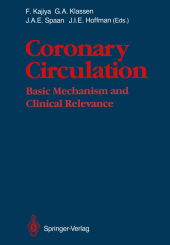 Neuerscheinungen 2011Stand: 2020-01-07 |
Schnellsuche
ISBN/Stichwort/Autor
|
Herderstraße 10
10625 Berlin
Tel.: 030 315 714 16
Fax 030 315 714 14
info@buchspektrum.de |

Julien I. E. Hoffman, Fumihiko Kajiya, Gerald A. Klassen, Jos A. E. Spaan
(Beteiligte)
Coronary Circulation
Basic Mechanism and Clinical Relevance
Herausgegeben von Kajiya, Fumihiko; Klassen, Gerald A.; Spaan, Jos A. E.; Hoffman, Julien I. E.
Softcover reprint of the original 1st ed. 1990. 2011. xi, 336 S. XI, 336 pp. 141 figs. including 4 in c
Verlag/Jahr: SPRINGER, BERLIN; SPRINGER JAPAN 2011
ISBN: 4-431-68089-6 (4431680896)
Neue ISBN: 978-4-431-68089-5 (9784431680895)
Preis und Lieferzeit: Bitte klicken
Coronary heart disease is one of the major health problems in indus trialized nations because of its high incidence and severity. Recent innovations in medical and surgical treatment of coronary heart dis ease have increased the importance of accurate diagnostic methods for determining the severity of coronary disease, identifying potential treatment alternatives, and evaluating the results of treatment. Great advances have also been made in basic research on coronary circula tion and its interaction with myocardial contraction and relaxation and neural and humoral control. With respect to these developments, the papers included in the present monograph deal with important topics concerned with the basic mechanism of coronary circulation as well as ones of clinical relevance. It is directed toward physicians (cardiologists, cardiac surgeons, cardiac radiologists, anestheologists, and others) and basic scientists (e.g., physiologists, bioengineers). We would like to em phasize the importance of a multidisciplinary approach in which basic scientists and clinicians work closely together. This volume consists of nine chapters. Chapter 1 contains macro scopic and microscopic descriptions of coronary vascular anatomy, which is closely related to the functions of coronary circulation. In Chap. 2 two methods in current use to evaluate phasic coronary blood velocity waveforms are presented, i.e., the laser Doppler and ultrasound Doppler methods. Chapter 3 describes the mechanical properties of coronary circulation, a knowledge of which is indispens able for an understanding of coronary arterial and venous blood flow velocity waveforms in relation to cardiac contraction and relaxation.
1. Anatomy of Coronary Circulation.- Anatomical Principles of the Coronary Circulation.- Flow Strategy and Functional Design of the Coronary Network.- 2. Measurements of Epicardial Coronary Artery and Vein Flow Velocity Waveforms on Left and Right Ventricles.- Evaluation of Coronary Blood Flow by Fiber-Optic Laser Doppler Velocimeter.- Ultrasonic Measurements of Coronary Blood Flow.- 3. Mechanical Properties of Coronary Circulation and Its Contribution to Coronary Hemodynamics.- Coronary Circulation Mechanics.- Functional Characteristics of Intramyocardial Capacitance Vessels and Their Effects on Coronary Arterial Inflow and Venous Outflow.- Input Impedance of the Canine Coronary Arterial Tree.- Pressure-Flow Relationships of the Coronary Arteries.- Effect of Ventricular and Extraventricular Pressure on the Coronary Artery Pressure-Flow Relationship.- 4. Transmural Myocardial Perfusion.- Transmural Myocardial Perfusion.- 5. Coronary Microcirculation.- Characteristics of Velocity Waveform and Radius in Epimyocardial Microvessels in Beating Left Ventricle.- Evaluation of the Velocity Waveform in Intramyocardial Small Vessels.- Microvascular Pressure Profiles in the Left and Right Coronary Circulations.- 6. Control of Coronary Circulation.- Mechanisms of Control in the Coronary Circulation.- Sympathetic Control of the Coronary Circulation.- Humoral Control of the Coronary Circulation.- Static and Dynamic Control of the Coronary Circulation.- 7. Coronary Circulation in Pathophysiological Conditions.- Coronary Circulation in Myocardial Hypertrophy.- Provocation of Coronary Spasm and Its Pathophysiology: Experimental Studies.- 8. Coronary Collaterals.- Development of Coronary Collaterals.- A Conscious Animal Model for Studies of Coronary Collateral Blood Flow Dynamics.- 9. Clinical Evaluation of Coronary Circulation.- Coronary Reserve in the Human Coronary Circulation.- Flow Dynamics in Coronary Stenosis.- Characteristics of Coronary Artery Blood Velocity Waveforms in Aortic Stenosis and Regurgitation.- Coronary Circulation in Patients with Typical Angina Pectoris but Normal Coronary Angiograms.- Blood Velocity Waveforms in Coronary Bypass Grafts.- Index of Key Words.


